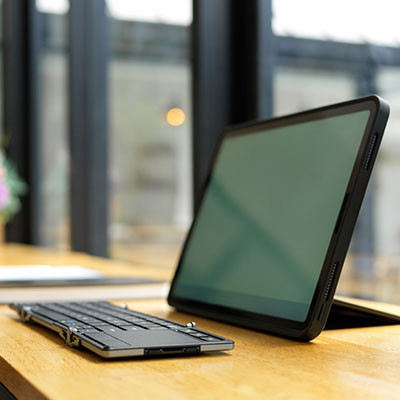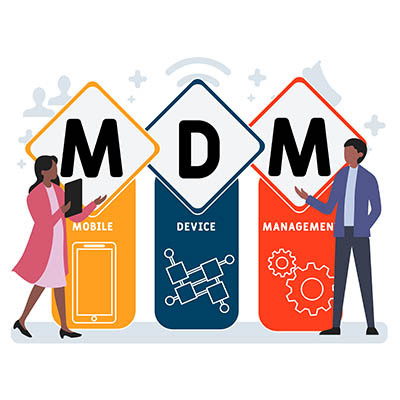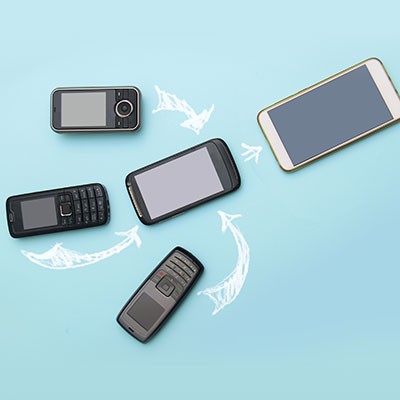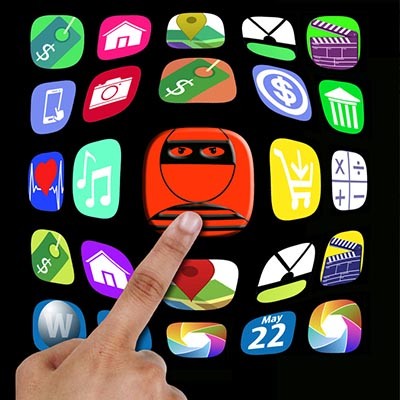It’s not hyperbole to suggest that many people in business these days prefer digital communication over the alternative. Smartphones have evolved over time and adapted to this need. That said, using a smartphone to communicate does still have its fair share of unwritten rules to follow. Let’s discuss some of the dos and don’ts of smartphones.
k_Street Consulting, LLC Blog
As mobile technology becomes ingrained in daily life, businesses must confront the fact that it is a whole new thing that has to be managed. Over 85 percent of the global population is actively using smartphones, and that means that with the benefits, there is also the substantial risk of cyberthreats targeting these devices. Let’s take a look at how mobile devices can be an untapped resource for your business.
Most businesses will find themselves holding on to spare technology, just in case they need it for any reason in the future. Storing this technology to ensure longevity, functionality, and safety is incredibly important. Today, we want to share some best practices to ensure that your stored tech will work as you need it to when it finally comes out of storage.
The smartphone has become the go-to device for most people’s personal computing. With the aid of well-developed mobile applications, people are able to manage their digital lives, while also accessing resources that make managing all other aspects of their lives easier. Below are four tips to help you make the most of your smartphone.
We’ve all felt the momentary panic when we reach for our pocket to pull out our smartphone, only to realize that it’s not there. This panic is indicative of a deeper issue with how our society has become reliant on technology, so much so that we have miniature computers in our pockets at all times. Are you using your smartphone as a distraction tool or as a productivity tool? That’s what we’re trying to answer with today’s blog.
Smartphones have managed to hold out against ransomware a bit longer than other hardware and operating systems, but those days are coming to an end. It’s important to remember that the average smartphone is not protected with antivirus software and thus remains threatened by your standard ransomware attacks. It is absolutely critical that your business doubles down on its protection against ransomware, especially in the mobile market.
There were a few years there about a decade ago when everyone had to have the latest tablet and tech experts were predicting that most of the world’s productivity would be done using touchscreen devices. On one hand, they weren’t that far off. On the other hand, tablet sales fell off about as rapidly as they had spiked, leaving some question over the future of the form factor. Of course, tablets settled in as great personal computers, but their use in business has seemingly plateaued. Let’s take a look at how businesses use tablets and answer if they are right for your business.
The modern smartphone market is one of ingenuity, communication, and productivity, all of which are extraordinarily important in today’s business world. To help you stay apprised of the various developments in the smartphone market, we’ve put together a blog detailing the various flagship smartphone devices for early 2022.
With remote work still widely in place, the idea of lost or stolen devices has many companies terrified. Due to this security issue, you must consider what you might do should someone lose track of one of your company’s devices. Here are four ways that you can take preventative measures to ensure that lost or stolen devices don’t become a major security risk for your business.
Mobile technology has permeated the workplace in countless ways. Many businesses will provide company-owned devices, be they laptops or smartphones, to employees so they can get work done while out of the office. This brings several opportunities for productivity into focus, but it also highlights some of the many risks associated with mobile devices.
Generally speaking, we all get way too much screen time nowadays, between the workstations we all spend our days in front of to the televisions we watch in the evening to the mobile devices that are never far out of reach. While plenty of people have weighed in on the subject, some of the most interesting insights come from scholarly research: the more notifications a person gets, the more their productivity suffers.
More businesses rely on their mobile strategies than ever before. For the most part, this uptick in mobility has helped sustain some business at a time when many would be expected to fail, but relying more on mobile definitely comes with some risks. This month we thought we would take a long look at mobility and how it can be a risky proposition for the modern small business.
Mobility has to be one of the most talked about technology trends in business, and for good reason. Consumers use mobile. They use it for shopping, banking, checking the weather, for driving directions; and today, they use it for productivity. Let’s take a look at the rise in mobility and how small businesses can use it to their benefit.
“So, where have you been working?”
This isn’t an uncommon greeting when you haven’t seen someone in a while. With COVID-19’s influence, many people would answer that they have been working from home, if possible. While business owners may be resistant to the idea of remote work, the potential benefits make it possible that remote work is the silver lining to the coronavirus cloud hanging over us.
It may not seem like it, but the mobile device is very much like the Internet. They’ve both only been around a short time, demand for each is massive, and their mere presence has changed modern life. Today, we’ll take a look at how the mobile device came to be and give you a brief look at mobile device history.
There is no question that smartphones have assimilated into our daily communications, both on a personal level and in the professional sense. Apps allow us to be social, to accomplish work-related tasks, and yes, kill some time with the latest silly trending game. Of course, as time passes, these devices only grow more advanced. If you’re due for a replacement, you may want to examine some of your options before pulling the trigger.
We go into great depth on how to protect your desktop and laptop computers from malware and other malicious threats. In fact, one of the first steps you take anytime you are setting up a new computer is to install antivirus and other security programs. You do this because an unprotected device presents substantial risk. With the way people are using their smartphones today, it’s a solid practice to outfit your mobile device with the security software needed to maintain the security of your data.
Sometimes a virus or malware infection can be so bad that the best solution is to completely wipe the device and start over with a factory reset. This can be pretty annoying. A new type of malware targeting Android devices just found a way to become even more annoying by being able to withstand a complete factory reset.
With more workers opting for mobile solutions than ever before, communications can be tricky to manage for a business. However, is your business’ infrastructure capable of adapting to these new developments in communication technology? You can bet that regardless of where the business takes you, certain applications and devices will always be useful throughout the workday.
We all download apps. There are literally millions of apps to choose from and sometimes nefarious developers can get their application published with ulterior motives. A situation has just happened as Google has removed twenty-two apps that were found to contain automated click-fraud scripts from the Google Play Store. We’ll take a short look at what these developers were up to, and how the fraudster would affect you if you were one of the two million users that happened to download these apps.
With the new innovations made to smartphones every year, you’d be hard-pressed to understand how the global smartphone has hit the skid. While Apple and Samsung sit pretty with large market shares, manufacturers that we’ve come to expect near the top of the smartphone market: Blackberry, HTC, and Nokia are but bit players. Their largest competition is now coming from Chinese companies Xiaomi, Huawei, and OnePlus.
Flexibility is an important part of the modern work environment, especially as technology has made it much easier to work anytime, anywhere. Employees understand that this flexibility exists in many industries, and they want to reap the benefits of a flexible work environment. However, it’s not that easy; there are quite a few pitfalls that can easily take a stab at your business’s productivity.
Smartphones, laptops, tablets, and other mobile technology are practically necessities in today’s modern workplace; especially if you want to keep productivity flowing at all times. However, implementing mobile devices into your workplace infrastructure is more complicated than it sounds, especially if you want to preserve security. Here are three topics to consider when implementing mobile devices in the workplace.
The use of mobile and personal devices for work purposes can be beneficial to your business operations. When handled, and supported properly, they have been shown to improve communication methods and increase productivity. However, the popularity of mobile computing, as well as the Internet of Things’ rapid expansion, means it’s more important than ever to make sure that you don’t allow dangerous devices to access your network. To keep your network safe, there are a few Mobile Device Management best practices that you should begin enforcing.
The Internet of Things has become one of the central parts of connectivity in a tech-centric world. Despite the incredible convenience that these devices offer to users, they come with considerable security risks that absolutely need to be kept in mind. We’re going to discuss some of the ways you can keep the IoT from being a security hazard while optimizing how much you get out of it.
As technology has improved in function and convenience, we seem to demand more and more of it at an increasing pace. Take mobile data as an example: 4G was introduced in 2009, and less than a decade later, there is high demand for 5G. Unfortunately, while 5G has been worked on for some time already, it isn’t likely that it will be commonly available anytime soon.
The Internet of Things is a bit of a paradox in and of itself. It has been leveraged to accomplish great things, but at the same time, it can be used in a way that can create considerable problems. However, innovations have proven that the IoT isn’t going anywhere, anytime soon, especially now that it can use the devices that we carry in our pockets.
When it comes to selecting a smartphone, most consumers look to the camera as a major deciding point - after all, many popular applications geared toward the everyday user heavily lean on the use of a camera. This utility and, in some ways, reliance have only encouraged rapid advancement to phone-based camera technology since its origins in the Samsung SCH-V200.
So many devices have entered the workplace that it’s mind-boggling to think about how they will affect operations and security. However, it’s crucial to know how this will affect your business in the future. These connected “Internet of Things” devices could have a major impact on how you run your business in 2018, so take a moment to see what the experts at HAX Hardware Trends have to say about it:
You and your employees no longer have to be stuck in the traditional office setting as you accomplish your daily tasks and responsibilities. Now, you can accomplish the same things from very different locations, including the airport as you wait for your flight to board, the coffee shop as you sip on your beverage, the office of your valued client, or the hotel that’s hosting a networking event. No longer does a worker need to be tied to a desk in order to work, and in order to survive, your business would do well to adopt these changes as well.
Did you know that, according to Gartner, a whole 80 percent of all employees bring their personal mobile devices to the office? It’s a rather troubling development for business owners who want to secure their data and keep their employees productive. However, this Bring Your Own Device (BYOD) trend has proved extremely beneficial for prepared organizations. This must prompt the question of how your business manages mobile devices in the workplace.
Small and medium-sized business owners are finding that it’s getting more difficult to compete without the means to deploy the newest technologies. Larger organizations are finding greater market shares, but smaller businesses have some advantages, namely in terms of maneuverability. With the help of some external resources, SMBs can be operate as effectively as larger organizations.
Your business needs to focus on mobility, and in doing so, you’ll be able to take advantage of many benefits. Yet, this isn’t to say that mobility doesn’t come with its fair share of problems. As a business owner, it’s your responsibility to determine whether or not you want to provide mobile devices to your staff. Just know: the benefits, when handled properly, can far outweigh the risks.
Mobile devices have grown extraordinarily popular in the workplace. Organizations find them to be of considerable value for staying connected and getting work done while outside the office. This trend has presented a serious risk in the form of network and data security. How can businesses support mobile devices in the workplace, without compromising on the security of the device and the data it holds?
 Computer monitors have been getting bigger and brighter for years; improving on picture quality, responsiveness, and energy efficiency. However, working in a dark room in front of a bright screen can lead to eye strain and even headaches. You can avoid these side effects by lowering the brightness on your screen. Furthermore, lowering your screen’s brightness can save you precious battery life on your laptop, so it’s worth keeping these tips in mind for that fact alone.
Computer monitors have been getting bigger and brighter for years; improving on picture quality, responsiveness, and energy efficiency. However, working in a dark room in front of a bright screen can lead to eye strain and even headaches. You can avoid these side effects by lowering the brightness on your screen. Furthermore, lowering your screen’s brightness can save you precious battery life on your laptop, so it’s worth keeping these tips in mind for that fact alone.
 The Internet of Things is practically omnipresent in today’s environment, and many commercial products not only connect to the Internet, but they also come with an app. Due to this type of integration growing more popular, the world is starting to see Internet-connected products that really don’t have much to gain from their connectivity.
The Internet of Things is practically omnipresent in today’s environment, and many commercial products not only connect to the Internet, but they also come with an app. Due to this type of integration growing more popular, the world is starting to see Internet-connected products that really don’t have much to gain from their connectivity.
 If you allow your team to bring their mobile devices to work and use them for work purposes, you’re aware of the challenging nature of integrating devices like smartphones and tablets into the work environment. They allow employees to keep up with their email and stay productive while away from their desk, but they also present a security challenge that’s not so easily fixed. How can your business address the potential issues regarding these devices?
If you allow your team to bring their mobile devices to work and use them for work purposes, you’re aware of the challenging nature of integrating devices like smartphones and tablets into the work environment. They allow employees to keep up with their email and stay productive while away from their desk, but they also present a security challenge that’s not so easily fixed. How can your business address the potential issues regarding these devices?
 If you’ve ever taken your gadgets on the go for work purposes, you might have found that it’s somewhat difficult to get anything done with the limited computing potential of a smartphone or tablet. However, with the right technology, you can take full advantage of your mobile devices, especially if you’re using Windows 10 with its full Microsoft Office suite (Want to know if Windows 10 is right for your business? Reach out to us before you upgrade).
If you’ve ever taken your gadgets on the go for work purposes, you might have found that it’s somewhat difficult to get anything done with the limited computing potential of a smartphone or tablet. However, with the right technology, you can take full advantage of your mobile devices, especially if you’re using Windows 10 with its full Microsoft Office suite (Want to know if Windows 10 is right for your business? Reach out to us before you upgrade).
 Mobile devices are one of the hottest items for thieves to target. According to reports from Consumer Reports and LoJack, 2013 saw the theft of two million laptops and three million handsets. What this means for you is that having your mobile device stolen is probably a lot more likely than you would think.
Mobile devices are one of the hottest items for thieves to target. According to reports from Consumer Reports and LoJack, 2013 saw the theft of two million laptops and three million handsets. What this means for you is that having your mobile device stolen is probably a lot more likely than you would think.
 Remote technology is so efficient and popular that it’s infiltrating many industries that you’d be surprised to hear about. One such sector is the healthcare department. Some doctors are taking advantage of the leaps and bounds made by technology to help their patients get back on their feet as easily as possible.
Remote technology is so efficient and popular that it’s infiltrating many industries that you’d be surprised to hear about. One such sector is the healthcare department. Some doctors are taking advantage of the leaps and bounds made by technology to help their patients get back on their feet as easily as possible.
 Mobile technology has become so integrated into society that some people can’t even leave their smartphone at home for a few moments. As a business owner, you in particular know the value that mobile technology brings to your industry. You should know that there are plenty of common misconceptions surrounding how to get the most power from your mobile battery.
Mobile technology has become so integrated into society that some people can’t even leave their smartphone at home for a few moments. As a business owner, you in particular know the value that mobile technology brings to your industry. You should know that there are plenty of common misconceptions surrounding how to get the most power from your mobile battery.
 As the world pushes toward a more mobile era, so too does the workplace embrace Bring Your Own Device (BYOD) with open arms. As such, workers will need some type of network connection in order to access mission-critical corporate data. Therefore, if they can’t connect to a WiFi network, they’ll default to their cell provider’s mobile data plan.
As the world pushes toward a more mobile era, so too does the workplace embrace Bring Your Own Device (BYOD) with open arms. As such, workers will need some type of network connection in order to access mission-critical corporate data. Therefore, if they can’t connect to a WiFi network, they’ll default to their cell provider’s mobile data plan.
 Mobile devices have become such a popular computing medium that they’ve infiltrated the workplace. While the business owner might feel that these mobile devices can help employees gain more regular access to corporate data for more working hours, these same devices could potentially eat up those work hours with time wasted on mobile gaming or other recreational apps. What’s the truth about BYOD? Let’s find out.
Mobile devices have become such a popular computing medium that they’ve infiltrated the workplace. While the business owner might feel that these mobile devices can help employees gain more regular access to corporate data for more working hours, these same devices could potentially eat up those work hours with time wasted on mobile gaming or other recreational apps. What’s the truth about BYOD? Let’s find out.
 It’s the new year and most technology websites are posting cute blog articles like, “The Top Gadgets of 2014,” or “The Hottest Technologies of 2015.” That’s all well and good, but for today’s blog we want to break with tradition and write about the latest mobile technology from 10 years ago. We think this will give everybody some perspective on “The Best Gadgets of 2014.”
It’s the new year and most technology websites are posting cute blog articles like, “The Top Gadgets of 2014,” or “The Hottest Technologies of 2015.” That’s all well and good, but for today’s blog we want to break with tradition and write about the latest mobile technology from 10 years ago. We think this will give everybody some perspective on “The Best Gadgets of 2014.”
 Industries are constantly trying to save money and improve productivity in the workplace. A BYOD strategy, known as Bring Your Own Device, allows employees to achieve this new level of success. With employees bringing their own devices into the workplace, you would think that this saves the business the trouble of supplying them; but there’s some controversy over whether the reward is worth the risk.
Industries are constantly trying to save money and improve productivity in the workplace. A BYOD strategy, known as Bring Your Own Device, allows employees to achieve this new level of success. With employees bringing their own devices into the workplace, you would think that this saves the business the trouble of supplying them; but there’s some controversy over whether the reward is worth the risk.
 Of all the computer company rivalries going on, one of the largest and most well known is Apple vs. Microsoft. The storied competition between these two software giants has driven innovation forward for more than thirty years. Today, the frontlines of this battle take place between the two company's mobile divisions, and now there's a third major competitor in the mix.
Of all the computer company rivalries going on, one of the largest and most well known is Apple vs. Microsoft. The storied competition between these two software giants has driven innovation forward for more than thirty years. Today, the frontlines of this battle take place between the two company's mobile divisions, and now there's a third major competitor in the mix.
 Smartphones that have been running Microsoft's Windows Phone 8 mobile operating system have been manufactured for over a year and a half, and in that time, Android has wrestled the title of "most popular mobile OS" away from Apple's iOS. Windows Phone 8 devices currently sit third, making up just over 3% of all the world's mobile phones. Despite its place in the market, the world's largest software company will release the first major update to their Windows 8 Phone platform in the upcoming months, and early users are saying they're really hitting the mark.
Smartphones that have been running Microsoft's Windows Phone 8 mobile operating system have been manufactured for over a year and a half, and in that time, Android has wrestled the title of "most popular mobile OS" away from Apple's iOS. Windows Phone 8 devices currently sit third, making up just over 3% of all the world's mobile phones. Despite its place in the market, the world's largest software company will release the first major update to their Windows 8 Phone platform in the upcoming months, and early users are saying they're really hitting the mark.
 Awareness to business trends are important for any business owner. The savviest businessman finds a way to use the trending topics to improve their enterprise's operational efficiency. The trends of the past for small business computing seem to be focused on the establishment and practical use of technologies that are relatively new, but are in full practice in the business world. These technologies include the manufacturing and worldwide distribution of devices that enhance a user's connectivity by presenting powerful interfaces to take advantage of their incredible mobility.
Awareness to business trends are important for any business owner. The savviest businessman finds a way to use the trending topics to improve their enterprise's operational efficiency. The trends of the past for small business computing seem to be focused on the establishment and practical use of technologies that are relatively new, but are in full practice in the business world. These technologies include the manufacturing and worldwide distribution of devices that enhance a user's connectivity by presenting powerful interfaces to take advantage of their incredible mobility.









































